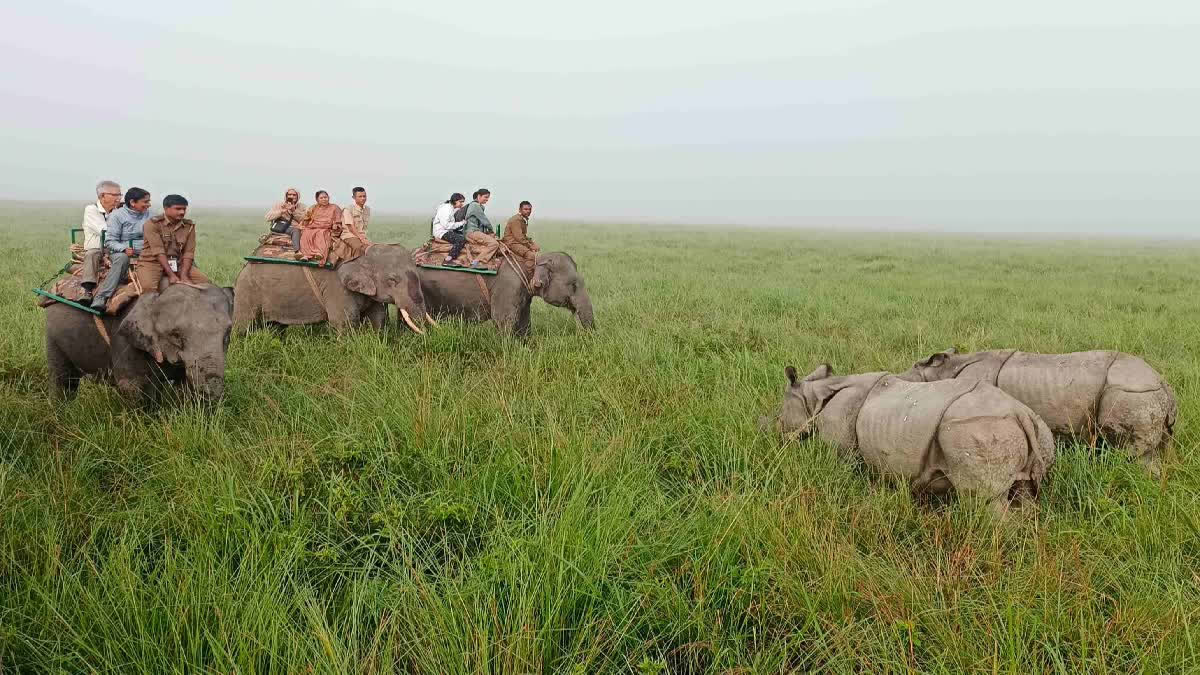Guwahati: The Assam government's eviction drives in the last two years have been yielding positive results. As the state government has taken a tough stand against encroachment, particularly in curbing such attempts in forest lands, the wild animals are now reclaiming lost habitats which belonged to them historically.
The Laokhowa Burhachapori Wildlife Sanctuary, which had been a rhino habitat earlier but was wiped off its one-horned rhino population, reported the presence of six rhinos on December 31, 2024.
The forest officials deployed at the Laokhowa Burhachapori Wildlife Sanctuary spotted two one-horned rhinos in the sanctuary in early 2023. The development assumed significance as it was after about 40 years that rhinos were spotted in the Laokhowa Burhachapori Wildlife Sanctuary.
"There were about 40-50 one-horned rhinos in Laokhowa Burhachapori Wildlife Sanctuary till 1983. While there was poaching that affected the rhino population, degradation of grassland habitat due to various anthropogenic reasons also reduced the number of the species. And there had been no rhinos left in the wildlife sanctuary after that," said Jayanta Deka, Divisional Forest Officer of Laokhowa Burhachapori Wildlife Sanctuary.
The positive development, however, took place in 2023 after the Assam government launched a massive eviction drive to clear encroachment, particularly from the forest lands. According to the statistics available from the Assam government, a total of 1892 hectares of land were cleared from encroachment with the eviction of 2,517 households in Burhachapori Wildlife Sanctuary.
"It was mainly due to the eviction drives carried out by the government that the rhinos and other wildlife are reclaiming their lost homeland now," said Jayanta Deka while adding that along with the rhinos, there were also tigers, deers, swamp deers, water buffalos and other wildlife which have been spotted in Laokhowa Burhachapori now.
Deka said that apart from the six one-horned rhinos there are about 30 elephants, tigers and other wildlife populations which have adopted Laokhowa Burhachapori as their habitat now. He said that after the massive eviction drive carried out in 2023 and notification of the first Addition area, the erstwhile 44.06 sq km Burhachapori Wildlife Sanctuary is now a 239.06 sq km protected area.
"The eviction drives carried out by the government established the contiguous landscape connecting Laokhowa Burhachapori Wildlife Sanctuary to Kaziranga National Park to its east and Orang National Park to the West of Laokhowa Burhachapori Wildlife Sanctuary," said Bibhab Talukdar, Chief Executive Officer (CEO) of the prominent biodiversity and nature conservation organisation, Aaranyak.
Talukdar, who is also the chair of the IUCN/Species Survival Commission, the Asian Rhino Specialist Group and Senior Advisor of the International Rhino Foundation for Asian Rhinos, said that Burhachapori along with adjacent Laokhowa wildlife sanctuaries is now secure breeding as well as habitat area for charismatic wildlife including the Royal Bengal Tigers, elephants, Hog deers, wild Boar, Asiatic Water Buffalos etc are now frequently seen in the area cleared of encroachment.
"As the government took a strong step and cleared the encroachment, it helped establish the contiguous landscape and facilitated the cross migration of the different animals. This can help genetic exchange between the rhinos and tigers in Kaziranga and Orang, which is also very vital for having a healthy stock and stable residential population of the species.
It may be mentioned here that two rhinos were introduced in Laokhowa Burhachapori under the Indian Rhino Vision 2020 programme in 2016. However, none of them survived owing to various factors. However, the habitat for rhinos remained intact there and research and documents carried out by experts have established that the twin sanctuaries of Laokhowa and Burhachapori still harbour habitat which can easily be ideal for 40 to 50 rhino population.



